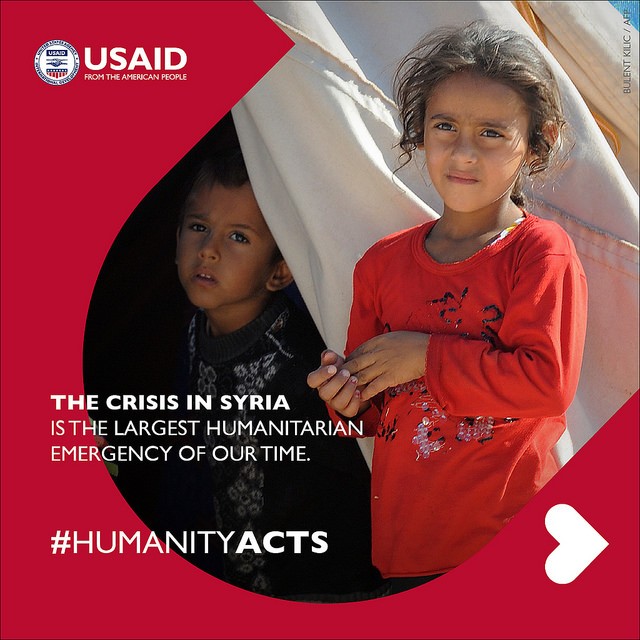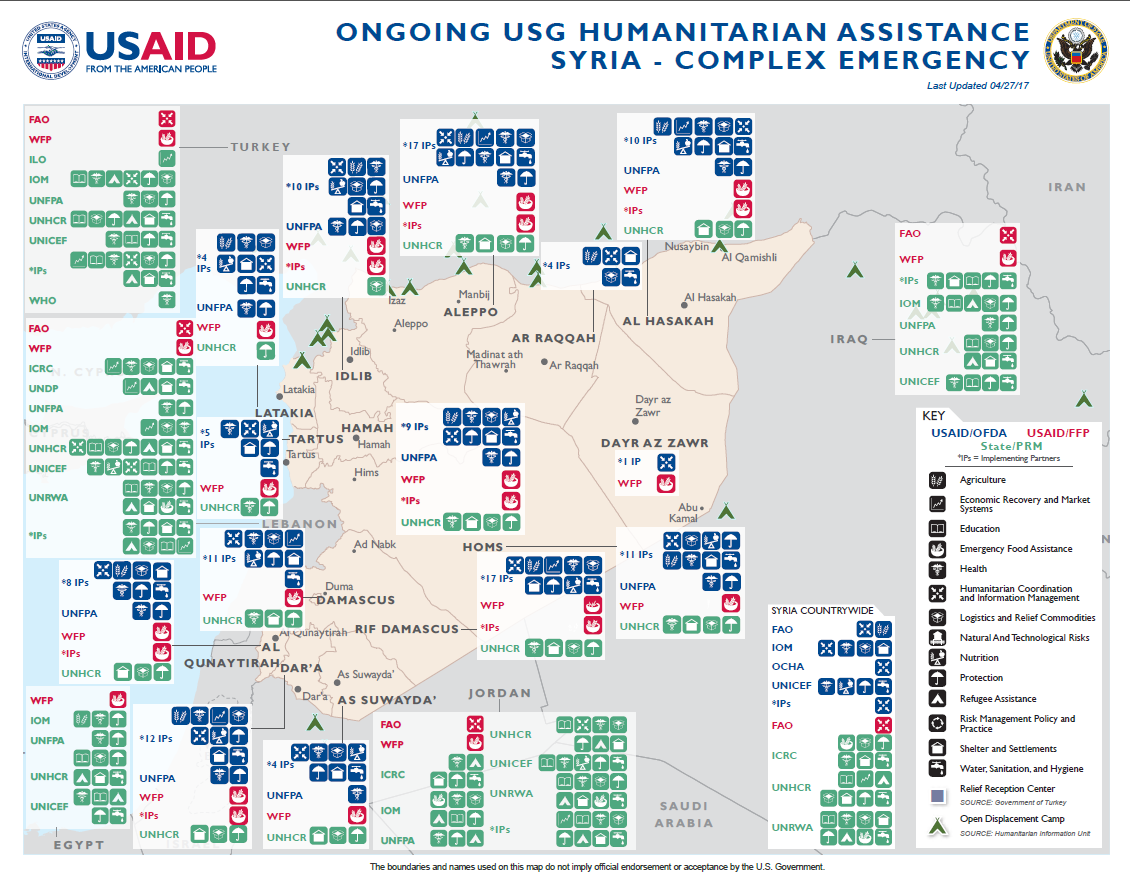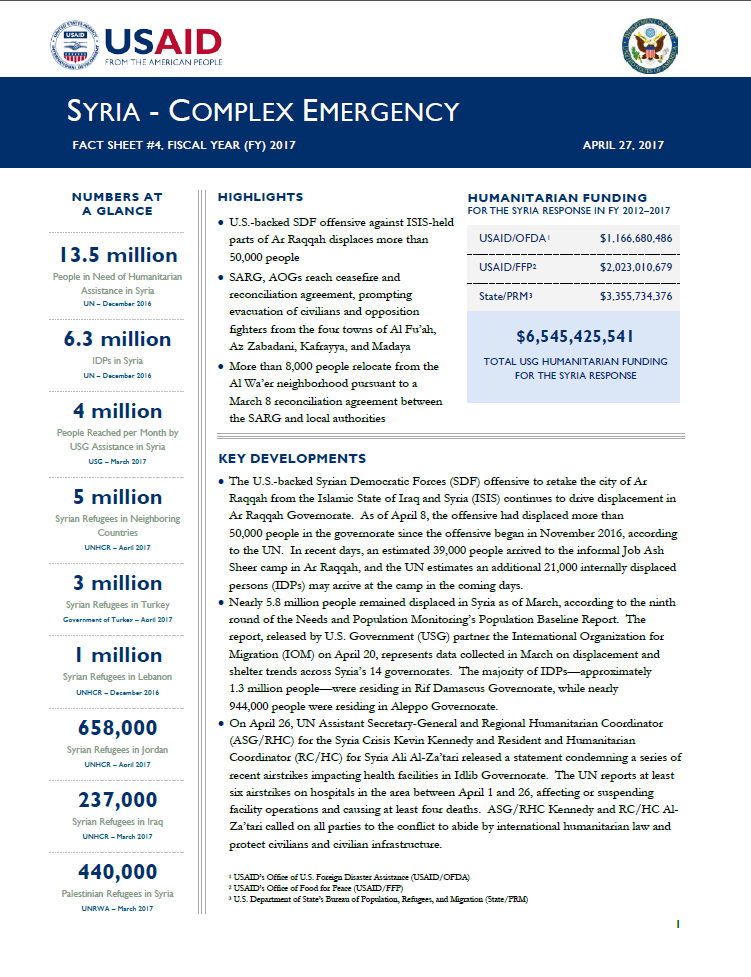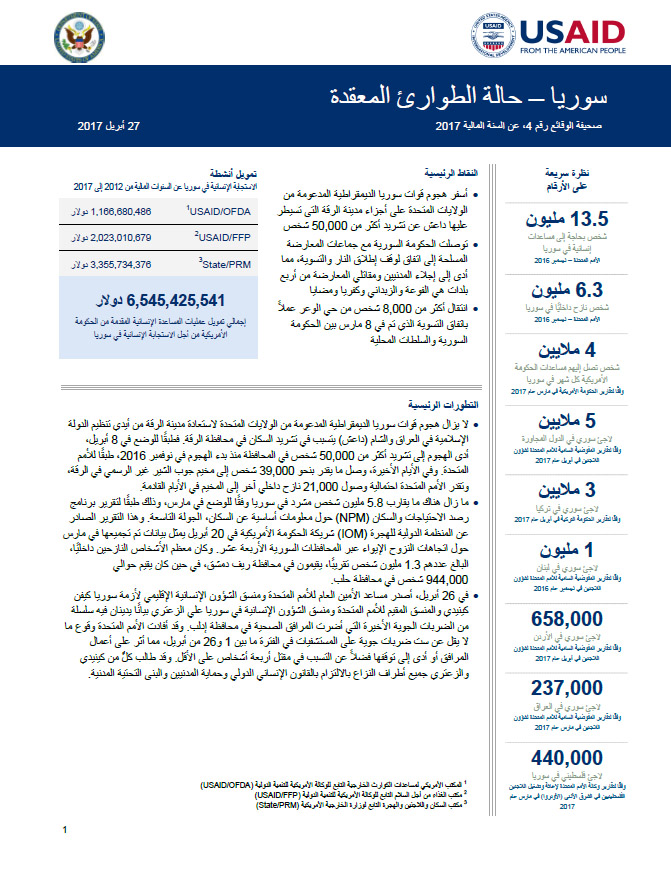- What We Do
- Agriculture and Food Security
- Democracy, Human Rights and Governance
- Economic Growth and Trade
- Education
- Ending Extreme Poverty
- Environment and Global Climate Change
- Gender Equality and Women's Empowerment
- Global Health
- Water and Sanitation
- Working in Crises and Conflict
- Disaster Assistance
- Political Transition Initiatives
- Conflict Mitigation and Prevention
- Countering Violent Extremism
- Disaster Risk Reduction
- Peacebuilding and Reconciliation
- Providing Safe & Secure Environments for Development
- Recovering From Crisis
- Resilience
- Tech Challenge for Atrocity Prevention
- World Humanitarian Day
- U.S. Global Development Lab
April 27, 2017
Highlights
U.S.-backed SDF offensive against ISIS-held parts of Ar Raqqah displaces more than 50,000 people
SARG, AOGs reach ceasefire and reconciliation agreement, prompting evacuation of civilians and opposition fighters from the four towns of Al Fu’ah, Az Zabadani, Kafrayya, and Madaya
More than 8,000 people relocate from the Al Wa’er neighborhood pursuant to a March 8 reconciliation agreement between the SARG and local authorities
Key Developments
The U.S.-backed Syrian Democratic Forces (SDF) offensive to retake the city of Ar Raqqah from the Islamic State of Iraq and Syria (ISIS) continues to drive displacement in Ar Raqqah Governorate. As of April 8, the offensive had displaced more than 50,000 people in the governorate since the offensive began in November 2016, according to the UN. In recent days, an estimated 39,000 people arrived to the informal Job Ash Sheer camp in Ar Raqqah, and the UN estimates an additional 21,000 internally displaced persons (IDPs) may arrive at the camp in the coming days.
Nearly 5.8 million people remained displaced in Syria as of March, according to the ninth round of the Needs and Population Monitoring’s Population Baseline Report. The report, released by U.S. Government (USG) partner the International Organization for Migration (IOM) on April 20, represents data collected in March on displacement and shelter trends across Syria’s 14 governorates. The majority of IDPs—approximately 1.3 million people—were residing in Rif Damascus Governorate, while nearly 944,000 people were residing in Aleppo Governorate.
On April 26, UN Assistant Secretary-General and Regional Humanitarian Coordinator (ASG/RHC) for the Syria Crisis Kevin Kennedy and Resident and Humanitarian Coordinator (RC/HC) for Syria Ali Al-Za’tari released a statement condemning a series of recent airstrikes impacting health facilities in Idlib Governorate. The UN reports at least six airstrikes on hospitals in the area between April 1 and 26, affecting or suspending facility operations and causing at least four deaths. ASG/RHC Kennedy and RC/HC Al-Za’tari called on all parties to the conflict to abide by international humanitarian law and protect civilians and civilian infrastructure.
Syria Complex Emergency - Map #4 FY2017 ![]() (pdf - 483k)
(pdf - 483k)
Numbers At A Glance
13.5 million
6.3 million
4 million
5 million
3 million
1 million
658,000
237,000
440,000
Humanitarian Funding
To Syria Humanitarian Response
FY 2012 - FY 2017
| USAID/OFDA | $1,166,680,486 |
| USAID/FFP | $2,023,010,679 |
| State/PRM | $3,355,734,376 |
| TOTAL | $6,545,425,541 |
Syria Complex Emergency - Fact Sheet #4 FY2017 ![]() (pdf - 216k)
(pdf - 216k)
INSECURITY AND POPULATION DISPLACEMENT
The Camp Coordination and Camp Management (CCCM) Cluster—the coordinating body for humanitarian CCCM activities, comprising UN agencies, non-governmental organizations (NGOs), and other stakeholders—recorded the displacement of more than 715,000 people from conflict-affected areas in northern and southern Syria between April 2016 and April 2017, including more than 68,000 people newly displaced in April alone. The figure includes nearly 700,000 people displaced from Aleppo, Ar Raqqah, Al Hasakah, Dayr az Zawr, Hamah, Homs, Idlib, and Lattakia governorates and up to 15,400 people displaced from Damascus, Dar’a, and Rif Damascus governorates.
Northern Syria
Displacement resulting from the U.S.-backed SDF offensive in Ar Raqqah remains fluid, with approximately 39,000 people arriving at the Job Ash Sheer site—an informal IDP camp near Ar Raqqah’s Job Ash Sheer village, located northwest of Ar Raqqah city—as of April 23; the figure comprises primary and secondary displacements. Most of the IDPs had relocated to a more secure and accessible IDP camp south of Tel Abyad District’s town of Ein Issa as of April 25. An additional 80,000 IDPs are sheltering in eight informal settlements in Ar Raqqah’s Karama sub-district southeast of Ar Raqqah. Displacement figures are expected to increase as the offensive advances toward Ar Raqqah city.
Humanitarian organizations, including USG partners, continue to respond to the needs of conflict-affected people in Ar Raqqah, as security conditions allow. On April 13, representatives of 25 UN agencies and NGOs participated in an interagency workshop in Erbil, Iraq, to enhance humanitarian coordination and inform an updated preparedness and response plan to address needs resulting from the SDF offensive in Ar Raqqah. Workshop sessions addressed humanitarian implications of the offensive, operational coordination, response strategy, and sectoral planning to inform the updated Ar Raqqah response plan.
As of April 11, CCCM Cluster members had established three IDP reception centers, including in Tel Abyad and at Al Hasakah’s Mabroka IDP site, and are establishing two additional centers in Aleppo’s Azaz and Jarablus districts. Humanitarian agencies are providing multi-sector assistance to people displaced by the offensive; in March, agencies reached more than 71,000 people with ready-to-eat (RTE) food rations, 12,000 people with relief commodities, and 4,200 people with a daily supply of safe drinking water.
Intensified airstrikes—allegedly led by the Syrian Arab Republic Government (SARG) and the Government of the Russian Federation (GoRF) and involving chemical weapons—struck opposition-held areas in southern Idlib’s Khan Shaykun sub-district on April 4, killing approximately 100 people and causing widespread injuries, according to USAID partners, the Syrian Observatory for Human Rights, and international media. A subsequent attack on April 4 struck a hospital in southern Idlib, where patients had relocated following an April 2 attack on another major hospital in the governorate, international media report. The attacks follow earlier accounts of the alleged use of chemical weapons in northern Hamah’s Kafr Zeita sub-district on March 30. USG partners provided relief assistance in response to the attacks, including mobilizing ambulances, providing medicine, and distributing informational brochures to raise awareness among health staff to build response capacity for potential future attacks.
The UN had registered more than 153,000 people in newly accessible neighborhoods in the city of Aleppo as of April 23. However, heavy structural damage, lack of infrastructure, and the presence of explosive remnants of war (ERW) and landmines continue to pose a threat to returnees, the UN reports. In March, the SARG Department of Health reported 21 deaths and more than 35 injuries resulting from ERW in Aleppo. Throughout the month of March, USG partner the Office of the UN High Commissioner for Refugees (UNHCR) assisted more than 108,000 IDPs in newly accessible areas of Aleppo, and IOM provided relief commodities, hygiene kits, and shelter materials for more than 37,000 people.
Southern and Central Syria
The evacuation of opposition-aligned fighters, their families, and other residents from Rif Damscus’ Az Zabadani and Madaya towns and Idlib’s Al Fu’ah and Kafrayya towns commenced on April 14, following a March 28 ceasefire and reconciliation agreement, international media report. Pursuant to the agreement, residents of SARG-held Al Fu’ah and Kafrayya will relocate to the SARG-controlled Jibreen town, located east of Aleppo city, while opposition fighters and civilians from opposition-held Az Zabadani and Madaya will relocate to opposition-controlled parts of Idlib.
On April 15, a vehicle-borne improvised explosive device exploded in the Rashideen suburb of Aleppo city, where a bus convoy transporting recently evacuated civilians and opposition fighters from Al Fu’ah and Kafrayya towns was awaiting entry into the city. The explosion resulted in at least 100 deaths and widespread injuries. The first phase of evacuations concluded on April 21 after a brief pause related to the April 15 bus convoy attack; an estimated 8,000 people from Al Fu’ah and Kafrayya and 3,000 people from Al Zabadani and Madaya had relocated as of April 21, according to international media. The agreement stipulates the transfer of approximately 30,000 people during the next two months. With support from the UN and its partners, the Syrian Arab Red Crescent (SARC) is providing food, health care services, relief commodities, and safe drinking water to evacuees arriving in Jibreen. NGOs are providing assistance to evacuees in Idlib at two reception centers.
As of April 25, more than 9,600 people had evacuated from Homs city’s Al Wa'er neighborhood and relocated primarily to Idlib and Aleppo’s city of Jarablus, in accordance with the March 13 reconciliation agreement between the SARG and armed opposition groups (AOGs), in which AOGs ceded control of the city to the SARG, according to the CCCM Cluster. A local NGO had delivered 1,000 RTE food rations and 1,000 kilograms of bread to people relocated in Jarablus as of April 11. Humanitarian organizations are providing food assistance, hygiene kits, and relief commodities to evacuees arriving in Idlib.
Increasing hostilities between SARG-GoRF forces and AOGs, including recent airstrikes by the SARG and the GoRF, in Hamah have displaced more than 52,000 people, including more than 12,500 people who fled to Idlib, since the AOG offensive against the SARG began on March 21, the UN reports. In March, USAID/FFP partner the UN World Food Program (WFP) provided food assistance to 35,000 people fleeing conflict in Hamah. SARC is also assisting IDPs from Hamah by providing food assistance and relief commodities, dispatching a mobile health clinic and nutritional teams, and providing safe drinking water in shelters.
HUMANITARIAN ACCESS AND ASSESSMENTS
As of April 19, the UN and its partners had deployed 14 interagency convoys across conflict lines and conducted nearly 60 airdrops to UN-identified hard-to-reach areas in 2017, delivering multi-sector assistance to an estimated 564,000 conflict-affected people in Syria, including nearly 160,000 people in UN-identified besieged areas. In 2016, the UN and its partners completed more than 130 cross-line convoys and nearly 170 airdrops, reaching more than 3.3 million people—a five-fold increase from the approximately 621,000 people reached in 2015. Despite these efforts, humanitarian convoys reached only 27 percent of targeted populations in need due to ongoing insecurity and continued bureaucratic obstructions by the SARG. The UN reports these impediments continue to limit humanitarian access to populations in need. According to January estimates from the UN, more than 4.7 million people live in UN-identified hard-to-reach areas, including nearly 644,000 people in besieged locations.
From March 14 to18, a humanitarian organization conducted a rapid assessment of education, food security, health, nutrition, protection, relief commodity, and shelter needs in approximately 120 communities in Ar Raqqah, including ISIS- and SDF-held areas. Respondents in both ISIS- and SDF-controlled areas reported sanitation issues, including excessive garbage and sewage in public areas. In addition, more than 60 percent and nearly 90 percent of respondents in ISIS- and SDF-held areas, respectively, reported incidents of child labor. Accessing markets, adequate shelter, food, and health care services were predominant challenges reported in ISIS-controlled areas, while these issues were not widely cited in SDF-held areas.
On March 29, a UN interagency assessment team visited the Mabroka IDP site to assess humanitarian response activities and identify persisting IDP needs. The site population had increased to 3,500 people—more than doubling since the last interagency assessment on March 20—and IDP needs exceeded the existing response capacity, according to camp management. At least three USAID partners are responding to the needs of IDPs sheltering at the site. Following the assessment, participating UN agencies, including IOM, the UN Children’s Fund (UNICEF), the UN Office for the Coordination of Humanitarian Affairs (OCHA), the UN World Health Organization (WHO), and UNHCR agreed to scale up assistance to address priority needs, including food, health care, relief commodities, and water, sanitation, and hygiene (WASH) assistance. The UN agencies also agreed to hold follow-on coordination meetings with all humanitarian organizations operating in the camp. Shelter partners are working to expand shelter capacity at the site, providing two large tents to provide temporary shelter for IDPs until individual tents can be allocated, while other humanitarian organizations are providing new arrivals with relief commodities, such as blankets and stoves.
An estimated 400,000 people remain in need of assistance in Rif Damascus’ Eastern Ghouta region, where continued fighting between the SARG and AOGs has limited humanitarian access since 2016. In anticipation of potential increased displacement to areas in and around Damascus and Rif Damascus, protection agencies are contributing to an inter-sector preparedness and response plan for Eastern Ghouta, UNHCR reports. Planned interventions include assessment and identification of protection needs; child protection, gender-based violence, and psychosocial services; and civil documentation and family reunification support.
AGRICULTURE AND FOOD SECURITY
In March, USAID/FFP partner WFP provided food assistance for more than 4 million people throughout Syria. The populations reached included nearly 613,000 people in hard-to-reach and besieged areas, indicating significantly greater access compared to January and February, when WFP reached 81,000 and 105,000 people in hard-to-reach and besieged areas, respectively. In coordination with WFP, the Food Security Cluster—the coordinating body for humanitarian food security activities, comprising UN agencies, NGOs, and other stakeholders—plans to provide food assistance for nearly 4.9 million people in April.
Data compiled from 17 food security agencies between October and December 2016 indicate that more than 80 percent of surveyed households employed emergency or crisis coping strategies, such as child labor, early marriage, selling assets, or reducing spending on other essential items, to meet basic food needs; nearly 50 percent of households reported inadequate dietary diversity; and nearly 40 percent of households demonstrated inadequate food consumption, despite receiving agriculture, food, or livelihoods assistance. The results were released in the Whole-of-Syria (WoS) food security sector’s inaugural Outcome Monitoring Initiative (OMI) report in mid-April and reflect food security data from approximately 11,700 households that received agriculture, food, and livelihoods assistance from partners operating across the three WoS hubs in Syria, Jordan, and southern Turkey. The WoS was implemented beginning in 2014 to improve delivery of humanitarian assistance through a common response plan and coordinated regional operations. The OMI aims to improve relief efforts by assessing the effectiveness of WoS food security sector assistance.
Humanitarian conditions in the besieged city of Dayr az Zawr are deteriorating, with recent reports of a starvation-related death and others in critical condition due to a lack of food, according to the UN. Households in Dayr az Zawr are resorting to extreme coping mechanisms and relying exclusively on food assistance from WFP and NGO partners to meet basic food needs, according to WFP’s March Vulnerability and Mapping Assessment. As of April 13, WFP had completed 221 airdrop rotations to besieged parts of the city since April 2016, dispatching approximately 4,200 metric tons of food commodities and relief supplies. Since July 2014, hostilities between SARG forces and ISIS around the city have constrained humanitarian access to an estimated 93,500 people residing in Dayr az Zawr.
Although WFP typically conducts airdrops in Dayr az Zawr’s western enclave, largely due to a lack of safe drop zones in other areas of the city, WFP completed airdrops in the eastern enclave on March 16, delivering 21,000 kilograms of lentils, sugar, and salt for approximately 1,200 households. WFP continues efforts to increase the frequency of assistance in the eastern enclave, as SARG airdrops—the primary source of food in the area—do not provide sufficient food supplies for those in need. To date in April, WFP has delivered 1,850 full food rations, sufficient to meet the food needs of 9,250 people in Dayr az Zawr.
The joint Cash-Based Responses Technical Working Group (CBR-TWG) and REACH Initiative monthly market monitoring exercise, conducted between March 20 and 27, revealed significant variations in the price for Survival Minimum Expenditure Baskets (SMEBs) across Syria. Countrywide, the median price of SMEBs—which comprise the minimum items required by a household for survival for one month, including cooking fuel, food, hygiene supplies, and safe drinking water—was approximately $125 in March; however, SMEBs purchased in western Dayr Az Zawr and besieged communities of Eastern Ghouta cost approximately $650 and $265, respectively. Additionally, the CBR-TWG and REACH Initiative noted that only some of the items comprising a standard SMEB were available in Dayr Az Zawr, where ongoing insecurity continues to impede humanitarian access and market supply chains. By comparison, the highest recorded cost for a SMEB in February was $175.
WASH AND HEALTH
An April 21 UN assessment mission to the Job Ash Sheer IDP site, where an estimated 39,000 people have fled in recent days, identified safe drinking water and WASH facilities as priority needs for IDPs sheltering in the camp. The site lacks latrines and bathing facilities, raising concerns about a deterioration of health and hygiene conditions, including the risk of waterborne disease outbreaks. In addition, daily water trucking provided by local authorities is reportedly sourced from a canal intended for irrigation purposes and is not suitable for consumption. To respond to the emergency WASH needs of IDPs at the site, humanitarian organizations installed 20 water tanks with a capacity to store up to 1,000 liters of safe drinking water on April 21. In addition, USG partner UNICEF plans to install 15 water tanks and distribute family hygiene kits to support 9,000 IDPs in the coming days. Humanitarian agencies also plan to erect 400 emergency latrines at the site.
With USAID/OFDA support, UNICEF continues to provide health, nutrition, and WASH assistance for populations sheltering at the informal Rukban and Hadalat settlements along the Syria–Jordan border berm. UNICEF provides daily water trucking in Rukban and Hadalat and is supporting construction and rehabilitation efforts of water systems at the sites, including the recent rehabilitation of a water borehole and installation of a water treatment unit in Hadalat. Between November 2016 and April 2017, UNICEF provided nearly 800 medical consultations, including for more than 650 children younger than five years of age, and screened more than 180 children for malnutrition.
In March, USG partner the UN Relief Works Agency for Palestine Refugees in the Near East (UNRWA) immunized more than 12,000 children ages five years and younger as part of the SARG Ministry of Health polio vaccination campaign. In addition to the polio vaccination campaign, UNRWA continued to provide essential health care services through 26 health facilities throughout Syria. Between March 1 and 31, health care workers at the UNRWA facilities conducted nearly 76,300 health consultations.
Attacks on health facilities continue to affect relief operations in Syria, with approximately 14 health facilities attacked during March, the Health Cluster reports. On April 17, three airstrikes hit a child and maternity hospital in Idlib, wounding at least five medical staff, causing significant structural damage, and prompting the hospital’s closure, according to the Union of Medical Care and Relief Organizations (UOSSM). UOSSM reports that a second hospital was attacked in Damascus on April 17, damaging an ambulance and prompting the hospital to suspend operations. Two additional airstrikes impacted hospitals in Idlib’s Kafr Nobol sub-district and Kafr Takharim city on April 22 and 25, respectively, causing both facilities to suspend operations. The airstrike in Kafr Nobol resulted in four deaths, according to the Health Cluster. In 2016, WHO confirmed nearly 340 attacks on health facilities throughout Syria, resulting in the deaths of more than 30 health care workers.
REFUGEE ASSISTANCE
UNHCR had registered more than 5 million Syrian refugees in neighboring countries, including Egypt, Iraq, Jordan, Lebanon, and Turkey, as well as parts of northern Africa, as of April 6. Turkey remains the largest host nation, with nearly 3 million Syrian refugees registered in the country.
In March, WFP continued to provided transitional food support to Syrian refugees in neighboring countries, including to more than 350,000 Syrian refugees living in camp and urban areas in Turkey. Since 2012, WFP’s food assistance programming has contributed to the local Turkish economy through the provision of approximately $250 million in electronic vouchers for Syrian refugees living in Turkey.
OTHER HUMANITARIAN ASSISTANCE
The Government of the UK (GoUK) announced additional support to assist the Syria health sector response, following the alleged chemical weapons attacks in opposition-held areas of Khan Shaykun on April 4. On April 9, the GoUK committed approximately $8.9 million to WHO and NGOs to provide access to safe drinking water for 500,000 people; medicine and medical supplies for 340 primary health clinics and nearly 70 hospitals; primary health and psychosocial assessments for more than 1 million people; and training for an estimated 400 health workers. On April 13, the Government of France also announced the provision of an emergency shipment of medical supplies to support the response to chemical weapons attacks in northern Syria.
On April 5, the Government of Estonia (GoE) announced its contribution of approximately $1.4 million to support humanitarian assistance activities in Syria and neighboring countries in 2018 and 2019. To date, the GoE has contributed nearly $7.4 million in humanitarian funding for the Syria response.
CONTEXT
Following the commencement of peaceful demonstrations against the SARG in March 2011, President Bashar al-Asad pledged legislative reforms. However, reforms failed to materialize, and SARG forces loyal to President al-Asad began responding to demonstrations with violence, leading armed opposition groups to retaliate.
At a November 2012 meeting in Doha, Qatar, Syrian opposition factions formed an umbrella organization—the National Coalition for Syrian Revolutionary and Opposition Forces, also known as the Syrian Coalition. The USG recognized the coalition as the legitimate representative of the Syrian people on December 11, 2012. On March 19, 2013, the Syrian Coalition established the Syrian Interim Government, which opposes the SARG and is based in decentralized locations throughout opposition-held areas of Syria.
On July 14, 2014, the UN Security Council adopted UN Security Council Resolution (UNSCR) 2165, authorizing UN cross-border and cross-line delivery of humanitarian aid to conflict-affected populations without SARG approval. The resolution permits the UN’s use of four border crossings from Turkey, Jordan, and Iraq—in addition to other crossings already in use by UN agencies—for delivery of humanitarian assistance into Syria. The resolution also establishes a monitoring mechanism under the authority of UN Secretary-General Ban Ki-moon and with the consent of the neighboring countries to ensure that deliveries across these border points contain only humanitarian items. The UNSC has subsequently adopted several resolutions renewing the mandate of UNSCR 2165, most recently in December 2016 with the adoption of UNSCR 2332, extending the authorities granted until January 2018.
Prior to the start of the conflict, UNRWA had registered approximately 560,000 Palestinian refugees in Syria, with more than 80 percent living in and around Damascus. Intense fighting in and around some Palestinian camps and neighborhoods has significantly affected Palestinian refugees in Syria. UNRWA estimates that approximately 60 percent of Palestinian refugees are displaced within Syria, with a further 110,000 Palestinian refugees displaced to neighboring countries. Syria also hosts an estimated 24,000 Iraqi refugees and asylum seekers, primarily in the greater Damascus area, as well as more than 3,200 refugee persons of concern from other countries.
PUBLIC DONATION INFORMATION
The most effective way people can assist relief efforts is by making cash contributions to humanitarian organizations that are conducting relief operations. A list of humanitarian organizations that are accepting cash donations for disaster responses around the world can be found at www.usaid.gov/crisis/syria.
The USG encourages cash donations because they allow aid professionals to procure the exact items needed (often in the affected region); reduce the burden on scarce resources (such as transportation routes, staff time, and warehouse space); can be transferred very quickly and without transportation costs; support the economy of the disaster-stricken region; and ensure culturally, dietary, and environmentally appropriate assistance.











Comment
Make a general inquiry or suggest an improvement.